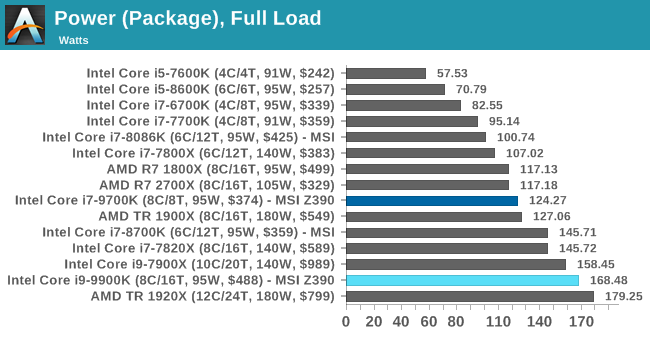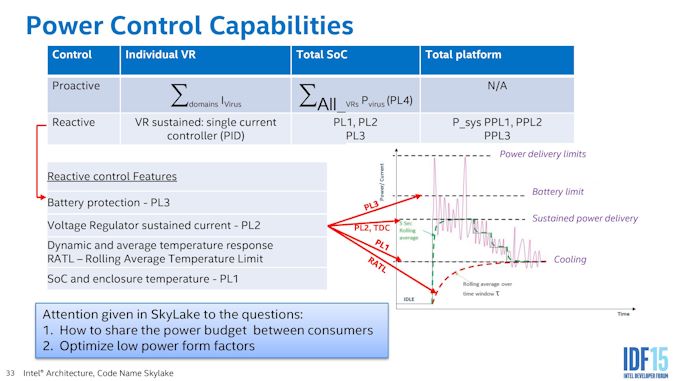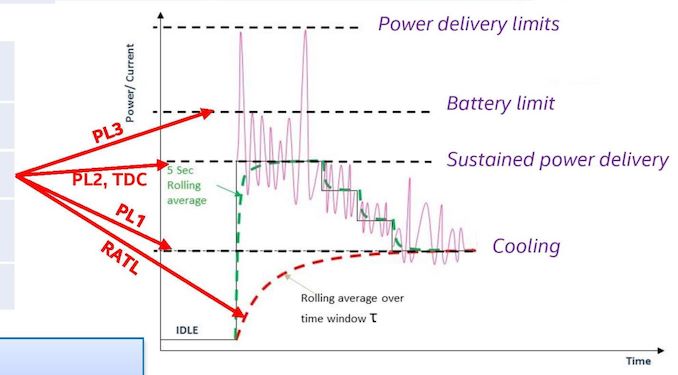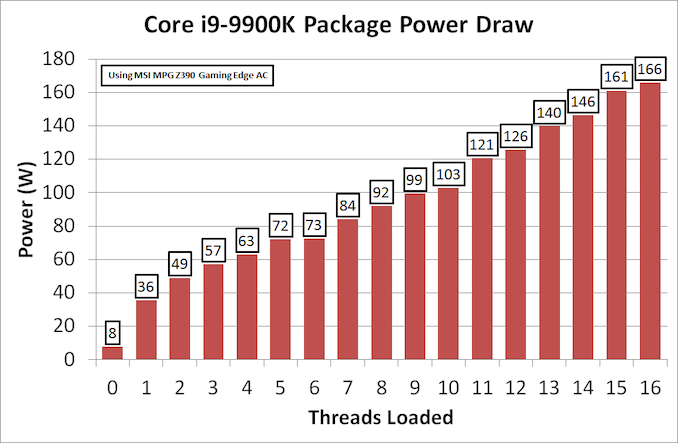The Intel 9th Gen Review: Core i9-9900K, Core i7-9700K and Core i5-9600K Tested
by Ian Cutress on October 19, 2018 9:00 AM EST- Posted in
- CPUs
- Intel
- Coffee Lake
- 14++
- Core 9th Gen
- Core-S
- i9-9900K
- i7-9700K
- i5-9600K
Power Consumption
TDP or not the TDP, That is The Question
Notice: When we initially posted this page, we ran numbers with an ASRock Z370 board. We have since discovered that the voltage applied by the board was super high, beyond normal expectations. We have since re-run the numbers using the MSI MPG Z390 Gaming Edge AC motherboard, which does not have this issue.
As shown above, Intel has given each of these processors a Thermal Design Power of 95 Watts. This magic value, as mainstream processors have grown in the last two years, has been at the center of a number of irate users.
By Intel’s own definitions, the TDP is an indicator of the cooling performance required for a processor to maintain its base frequency. In this case, if a user can only cool 95W, they can expect to realistically get only 3.6 GHz on a shiny new Core i9-9900K. That magic TDP value does not take into account any turbo values, even if the all-core turbo (such as 4.7 GHz in this case) is way above that 95W rating.
In order to make sense of this, Intel uses a series of variables called Power Levels: PL1, PL2, and PL3.
That slide is a bit dense, so we should focus on the graph on the right. This is a graph of power against time.
Here we have four horizontal lines from bottom to top: cooling limit (PL1), sustained power delivery (PL2), battery limit (PL3), and power delivery limit.
The bottom line, the cooling limit, is effectively the TDP value. Here the power (and frequency) is limited by the cooling at hand. It is the lowest sustainable frequency for the cooling, so for the most part TDP = PL1. This is our ‘95W’ value.
The PL2 value, or sustained power delivery, is what amounts to the turbo. This is the maximum sustainable power that the processor can take until we start to hit thermal issues. When a chip goes into a turbo mode, sometimes briefly, this is the part that is relied upon. The value of PL2 can be set by the system manufacturer, however Intel has its own recommended PL2 values.
In this case, for the new 9th Generation Core processors, Intel has set the PL2 value to 210W. This is essentially the power required to hit the peak turbo on all cores, such as 4.7 GHz on the eight-core Core i9-9900K. So users can completely forget the 95W TDP when it comes to cooling. If a user wants those peak frequencies, it’s time to invest in something capable and serious.
Luckily, we can confirm all this in our power testing.
For our testing, we use POV-Ray as our load generator then take the register values for CPU power. This software method, for most platforms, includes the power split between the cores, the DRAM, and the package power. Most users cite this method as not being fully accurate, however compared to system testing it provides a good number without losses, and it forms the basis of the power values used inside the processor for its various functions.
Starting with the easy one, maximum CPU power draw.

Focusing on the new Intel CPUs we have tested, both of them go beyond the TDP value, but do not hit PL2. At this level, the CPU is running all cores and threads at the all-core turbo frequency. Both 168.48W for the i9-9900K and 124.27W for the i7=9700K is far and above that ‘TDP’ rating noted above.
Should users be interested, in our testing at 4C/4T and 3.0 GHz, the Core i9-9900K only hit 23W power. Doubling the cores and adding another 50%+ to the frequency causes an almost 7x increase in power consumption. When Intel starts pushing those frequencies, it needs a lot of juice.
If we break out the 9900K into how much power is consumed as we load up the threads, the results look very linear.
This is as we load two threads onto one core at a time. The processor slowly adds power to the cores when threads are assigned.
Comparing to the other two ‘95W’ processors, we can see that the Core i9-9900K pushes more power as more cores are loaded. Despite Intel officially giving all three the same TDP at 95W, and the same PL2 at 210W, there are clear differences due to the fixed turbo tables embedded in each BIOS.
So is TDP Pointless? Yes, But There is a Solution
If you believe that TDP is the peak power draw of the processor under default scenarios, then yes, TDP is pointless, and technically it has been for generations. However under the miasma of a decade of quad core processors, most parts didn’t even reach the TDP rating even under full load – it wasn’t until we started getting higher core count parts, at the same or higher frequency, where it started becoming an issue.
But fear not, there is a solution. Or at least I want to offer one to both Intel and AMD, to see if they will take me up on the offer. The solution here is to offer two TDP ratings: a TDP and a TDP-Peak. In Intel lingo, this is PL1 and PL2, but basically the TDP-Peak takes into account the ‘all-core’ turbo. It doesn’t have to be covered under warranty (because as of right now, turbo is not), but it should be an indication for the nature of the cooling that a user needs to purchase if they want the best performance. Otherwise it’s a case of fumbling in the dark.














274 Comments
View All Comments
Total Meltdowner - Sunday, October 21, 2018 - link
Those typoes.."Good, F U foreigners who want our superior tech."
muziqaz - Monday, October 22, 2018 - link
Same to you, who still thinks that Intel CPUs are made purely in USA :DHifihedgehog - Friday, October 19, 2018 - link
What do I think? That it is a deliberate act of desperation. It looks like it may draw more power than a 32-Core ThreadRipper per your own charts.https://i.redd.it/iq1mz5bfi5t11.jpg
AutomaticTaco - Saturday, October 20, 2018 - link
Revisedhttps://www.anandtech.com/show/13400/intel-9th-gen...
The motherboard in question was using an insane 1.47v
https://twitter.com/IanCutress/status/105342741705...
https://twitter.com/IanCutress/status/105339755111...
edzieba - Friday, October 19, 2018 - link
For the last decade, you've had the choice between "I want really fast cores!" and "I want lots of cores!". This is the 'now you can have both' CPU, and it's surprisingly not in the HEDT realm.evernessince - Saturday, October 20, 2018 - link
It's priced like HEDT though. It's priced well into HEDT. FYI, you could have had both of those when the 1800X dropped.mapesdhs - Sunday, October 21, 2018 - link
I noticed initially in the UK the pricing of the 9900K was very close to the 7820X, but now pricing for the latter has often been replaced on retail sites with CALL. Coincidence? It's almost as if Intel is trying to hide that even Intel has better options at this price level.iwod - Friday, October 19, 2018 - link
Nothing unexpected really. 5Ghz with "better" node that is tuned for higher Frequency. The TDP was the real surprise though, I knew the TDP were fake, but 95 > 220W? I am pretty sure in some countries ( um... EU ) people can start suing Intel for misleading customers.For the AVX test, did the program really use AMD's AVX unit? or was it not optimised for AMD 's AVX, given AMD has a slightly different ( I say saner ) implementation. And if they did, the difference shouldn't be that big.
I continue to believe there is a huge market for iGPU, and I think AMD has the biggest chance to capture it, just looking at those totally playable 1080P frame-rate, if they could double the iGPU die size budget with 7nm Ryzen it would be all good.
Now we are just waiting for Zen 2.
GreenReaper - Friday, October 19, 2018 - link
It's using it. You can see points increased in both cases. But AMD implemented AVX on the cheap. It takes twice the cycles to execute AVX operations involving 256-bit data, because (AFAIK) it's implemented using 128-bit registers, with pairs of units that can only do multiplies or adds, not both.That may be the smart choice; it probably saves significant space and power. It might also work faster with SSE[2/3/4] code, still heavily used (in part because Intel has disabled AVX support on its lower-end chips). But some workloads just won't perform as well vs. Intel's flexible, wider units. The same is true for AVX-512, where the workstation chips run away with it.
It's like the difference between using a short bus, a full-sized school bus, and a double decker - or a train. If you can actually fill the train on a regular basis, are going to go a long way on it, and are willing to pay for the track, it works best. Oh, and if developers are optimizing AVX code for *any* CPU, it's almost certainly Intel, at least first. This might change in the future, but don't count on it.
emn13 - Saturday, October 20, 2018 - link
Those AVX numbers look like they're measuing something else; not just AVX512. You'd expect performance to increase (compared to AVX256) by around 50%, give or take quite a margin of error. It should *never* be more than a factor 2 faster. So ignore AMD; their AVX implementation is wonky, sure - but those intel numbers almost have to be wrong. I think the baseline isn't vectorized at all, or something like that - that would explain the huge jump.Of course, AVX512 is fairly complicated, and it's more than just wider - but these results seem extraordinary; and there' just not enough evidence the effect is real, not just some quirk of how the variations were compiled.